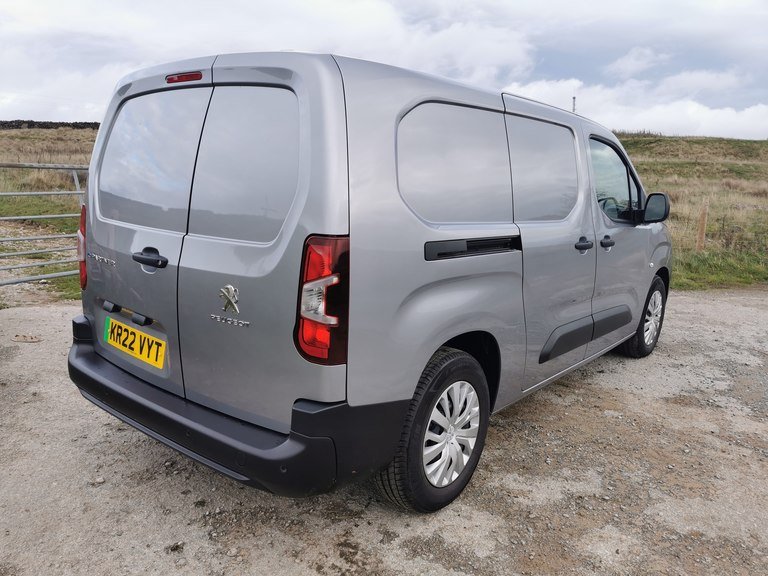Electric Vans / Electric Van Reviews / Peugeot e-Partner
The Peugeot Partner has long been a staple of the tradesperson. A decent loadspace and an excellent payload have made this van many friends over the years. But how well does it cope with the transition to zero-emission electrical power? Our Van Expert Tim Cattlin recently spent a week with one to find out…
As the smaller van is typically used in urban environments by small businesses, an electric version is probably going to appeal more than a zero-emission medium or large van. Why? Because the range between charges is less likely to be an issue, most vehicles returning to base at the end of the day with plenty of charge remaining and, with the advent of zero-emission zones, they will be able to enter inner city areas without paying a charge. On paper, the e-Partner ticks many boxes so it’s not surprising that, along with its platform sharing siblings from the Stellantis group it’s not only selling very well, it’s also won a number of industry awards.



There are two lengths, known as Standard or Long, and the e-Partner is offered in a choice of two trim levels, Professional Premium+ and Asphalt Premium+. If I’m honest, the van isn’t a head turner in looks but, it’s no ugly duckling either. On the higher trim model side rubbing strips help protect the van from some of the almost inevitable knocks and scrapes, and the steel wheels gain some nice trims. You’ll also get a body coloured rear bumper and front fog lights to brighten things up a bit.
This is an area of real strength for the diesel van, and from a load area perspective, the stats remain the same on this electric version. The Standard van has a load length of 1817mm and a total volume of 3.3 cubic metres, whilst the Long version offers 2167mm and 3.8 cubic metres. If you take advantage of the Multi-Flex folding seat and load through facility where fitted, you’ll be able to load pipes, timber etc. up to 3.44 metres long.
Twin rear doors together with a side loading door (you get one on each side on the Long model) provide safe and easy access to the load area, and, despite the weight of the battery pack, the van offers a healthy payload of up to 803kgs, depending on the model. Towing is permitted (not something you can take for granted on an electric van) although you’re limited to a maximum trailer weight of 750kgs.
The e-Partner is fitted with an electric motor that is rated at 100kw, equivalent to 136hp and underneath the van there’s a 50kWh battery pack which gives the van a range of 170 miles under the WLTP Combined test cycle. As ever, it’s important to use these figures as a basis for comparison between vans – weather and traffic conditions, gradients, payload and power used for the cab heater etc. will all eat into the remaining range. The test figure also assumes that the cab temperature has been ‘pre-conditioned’ prior to driving with the heater or air conditioning whilst connected to a mains charger.
The charging port is located behind a flap on the left side of the van, and charging will take around 7.5 hours from the commonly used 7.4kWh home or workplace wallbox, whereas a 100kW DC public chargepoint will get a fully depleted battery back to 80% of capacity in just half an hour.
Practical is probably the best way of describing the cab interior – it’s not cutting edge in design but that’s not a priority for many van users. Generally, it’s comfortable but, with storage being a challenge for designers of smaller vans there’s not a huge amount on offer although there are door bins and cup holders for those odd bits and bobs. The multimedia screen is angled towards the driver and the digital ‘i-Cockpit’ instrument panel is very clear, offering all the required information to the driver including the remaining range available.
The lack of noise is the first thing a driver more accustomed to a diesel engined van will notice upon driving away, although silence isn’t quite achieved, the motor providing a gentle whine. That torque is noticeable immediately, the driver not having to wait whilst an engine reaches 3000rpm or so to get that often much needed ‘oomph’. Visibility from the cab is good, assisted by decent sized door mirrors, and the van remained quiet on the road with little road or wind noise evident.
Whilst the ride and handling felt fine, less impressive was the steering which seemed vague, imprecise and a little unnerving. Other manufacturers such as Renault have got this aspect just right and it’s something that, in my opinion, needs attention.
It’s a great package – it’s got the range, a decent power unit, some decent spec and it’s a very competent load carrier. Whilst there’s some stiff competition in this small van sector the e-Partner can hold its head up high and ably compete with any of them.